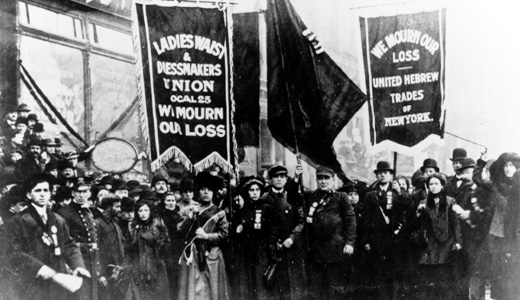
WASHINGTON (PAI) – A half-day-long Capitol Hill commemoration of the 100th anniversary of the Triangle Shirtwaist Company fire drew uncomfortable parallels with conditions facing workers today. The fire in Manhattan killed 146 young immigrant workers, almost all of them women.
Speakers, including Sally Greenberg of the National Consumers League, Mine Workers President Cecil Roberts and workers who suffered exploitation or have seen family members die, used the March 21 meeting to urge mass action to restore workers’ rights to collectively bargain and to toughen and enforce job safety and health laws.
The session honored the centennial of the fire that took place on the afternoon of March 25, 1911 at the Triangle Shirtwaist Co., a clothing maker – one of hundreds in lower Manhattan – that employed young, mostly Jewish and Italian immigrant women. Almost half were under 20. It even had children in a “kindergarten” snipping thread, speakers said.
Triangle was located on the top three floors of the Asch Building on Greene Street. It was actually one of the “better” sweatshops in the city – thanks to a citywide strike by 20,000 female garment workers 18 months before – but it wasn’t unionized.
When the blaze began, there was one exit. Triangle’s two owners deliberately padlocked it to prevent theft. There was flammable debris – cuttings and scraps – everywhere and the workers were allowed to smoke. The fire escapes were flimsy and ended far above street level. Stairwells quickly filled with smoke and flames. The elevator stalled, though one woman slid down its cable.
Fire department hoses couldn’t reach those top floors. The 18-minute blaze left workers with two horrific alternatives: burn to death or jump. Many burned. The rest jumped.
Speakers said such horrifying working conditions still exist, in the U.S. and worldwide. They cited such disasters as a 1991 poultry plant fire in Hamlet, N.C. – the doors were locked, again – the Texas City, Texas BP oil refinery blast in 2005 (15 dead, 180 injured), last year’s Gulf of Mexico disaster (11 died) and the Upper Big Branch coal mine explosion in West Virginia (29 died). Bangladesh was the international example.
The exploiters are the same, they said: Firms that put profits ahead of people. The predominant victims of such disasters are, still, those who are the most defenseless: The young, women, minorities and, importantly, non-unionized. They’re unprotected.
And they said workers and their allies must seize a present teachable moment – the Right Wing campaign to obliterate workers’ rights – to both re-energize the labor movement and to enlist allies and the general public. “Pay attention to the parallels between 1911 and today. Our call to action is really a manifesto,” Greenberg said.
Speakers explained how activists used the Triangle Fire and its aftermath, including acquittal of the company owners of manslaughter charges, both to grow unions – in particular the pioneering International Ladies Garment Workers – and to campaign successfully for reforms to health and safety laws, fire code improvement and enforcement and institution of workers comp.
Frances Perkins, a witness to the fire and then a social worker employed by the Consumers League, used its lessons to help draft and push through New Deal pro-labor legislation when she became Labor Secretary under FDR, her biographer Kirstin Downey said. “We’re continuing to deal with the same kinds of issues,” Downey added.
“We leave things to the market and this” – Triangle and subsequent workplace disasters – “is as good as it gets,” said University of Maryland history professor Robyn Muncy. “The market can’t be allowed to determine all the conditions under which people work,” added Georgetown University labor history professor Joe McCartin. “There needs to be a public interest.”
They will campaign for the same platform now: updating, strengthening and enforcing job and mine safety laws, preserving and enhancing minimum wage and anti-child-labor laws, bringing farm workers under child labor laws, saving worker protection programs from Right Wing budget raids, and upholding the right of collective bargaining.
The rights to organize and collectively bargain must be at the top of the list of ways to right present wrongs, just as they were in the New Deal, said Roberts, the keynote speaker. He was seconded by a last-minute addition to the program: Stephanie Bloomingdale, Wisconsin AFL-CIO Secretary-Treasurer – who commented on “our arsonist,” right-wing GOP Gov. Scott Walker, who set fire to workers’ rights there.
“No worker should have to listen to the boss say: ‘I want you to do A, B and C, and it’s dangerous,'” Roberts said. “Every worker should be empowered to look that boss in the eye and say: ‘Kiss my ass.'”
“If you want higher wages, join a union. If you want better health care, join a union. If you want health and safety on the job, join a union. If you want a greater America, join a union,” he declared.
And mass mobilization of unions and their allies – as in Wisconsin and Ohio and Indiana and elsewhere – “will move that agenda a lot faster,” Roberts added.
Photo: In this 1911 file photograph from the National Archives, labor union members gather to protest and mourn the loss of life in the March 25, 1911, Triangle Shirtwaist Factory fire in New York. (National Archives/AP)









